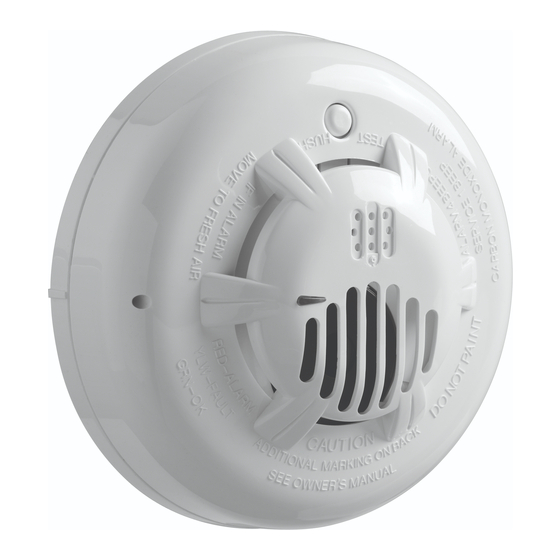DSC PG9933 Installations- und Betriebsanleitung für den Installateur - Seite 5
Blättern Sie online oder laden Sie pdf Installations- und Betriebsanleitung für den Installateur für Sicherheitssensoren DSC PG9933 herunter. DSC PG9933 9 Seiten. 915mhz wireless carbon monoxide detector

cause discomfort and adverse health effects, it is CO gas which presents the greatest
threat to life.
Carbon monoxide is produced by the incomplete combustion of fuels such as natural
gas, propane, heating oil, kerosene, coal, charcoal, gasoline, or wood. The incomplete
combustion of fuel can occur in any device which depends on burning for energy or
heat such as furnaces, boilers, room heaters, hot water heaters, stoves, grills, and in
any gasoline powered vehicle or engine (e.g., generator set, lawnmower). Tobacco
smoke also adds CO to the air you breathe. When properly installed and maintained,
your natural gas furnace and hot water heater do not pollute your air space with CO.
Natural gas is known as a "clean burning" fuel because under correct operating con-
ditions, the combustion products are water vapor and carbon dioxide (CO2), which is
not toxic. The products of combustion are exhausted from furnaces and water heaters
to the outside by means of a fuel duct or chimney. Correct operation of any burning
equipment requires two key conditions:
a. An adequate supply of air for complete combustion.
b. Proper ventilation of the products of combustion from the furnace through the
chimney, vent or duct to the outside.
Typical carbon monoxide gas problems are summarized here:
a. Equipment problems, due to defects, poor maintenance, damaged and cracked
heat exchangers.
b. Collapsed or blocked chimneys/flues, dislodged, disconnected or damaged vents.
c. Downdraft in chimneys or flues. This can be caused by very long or circuitous
flue runs, improper location of flue exhaust or wind conditions.
d. Improper installation or operation of equipment, chimney or vents.
e. Airtight homes with inadequate flow of fresh air for the combustion process.
f. Inadequate exhaust of space heaters or appliances.
g. Exhaust ventilation/fireplace competing for air supply.
Potential sources of carbon monoxide in your home or office include clogged chimney,
wood stove, wood or gas fireplace, automobile and garage, gas water heater, gas appli-
ance, gas or kerosene heater, gas or oil furnace, and cigarette smoke.
More information about conditions which result in transient CO
situations:
1. Excessive spillage or reverse venting of fuel burning appliances caused by:
a. Outdoor ambient conditions such as wind direction and or velocity, including
high gusts of wind; heavy air in the vent pipes (cold humid air with extended
periods between cycles).
b. Negative pressure differential resulting from the use of exhaust fans.
c. Simultaneous operation of several fuel burning appliances competing for lim-
ited internal air.
d. Vent pipe connection vibrating loose from clothes dryers, furnaces, or water
heaters.
e. Obstructions in unconventional vent pipe designs which amplify the above situ-
ation.
2. Extended operation of unventilated fuel burning devices (oven, fireplace, etc).
3. Temperature inversions which can trap exhaust gases near the ground.
4. Car idling in an open or closed attached garage, or near a home.
Possible Symptoms of Carbon Monoxide Poisoning
Carbon monoxide is colorless, odorless, tasteless, and very toxic. When inhaled, it pro-
duces an effect known as chemical asphyxiation. Injury is due to the combining of CO
with the available hemoglobin in the blood, lowering the oxygen- carrying capacity of
the blood. In the presence of CO gas, the body is quickly affected by oxygen star-
vation. The following symptoms are related to CO poisoning and should be discussed
with all members of the household:
a. Mild exposure: slight headache, nausea, vomiting, fatigue (often described as
"flu-like" symptoms).
b. Medium exposure: severe throbbing headache, drowsiness, confusion, fast heart
rate
c. Extreme exposure: unconsciousness, convulsions, cardiorespiratory failure, death.
d. Many cases of reported CARBON MONOXIDE POISONING indicate that
while victims are aware they are not well, they become so disoriented they are
unable to save themselves by either exiting the building or calling for assistance.
Young children and household pets are typically the first affected.
Action to Take When Alarm Sounds
In case harmful levels of CO gas are detected, your detector will go into continuous
full alarm. Try to take the following necessary actions immediately:
1. Push the detector Test/Hush switch to silence the alarm. Warning: Never remove
the battery to silence the alarm. Removing the battery removes your protection!
Pushing the Test/Hush button mutes the alarm for 5 minutes. After 5 minutes, the
alarm resumes if CO levels remain high. Call your emergency service. Please
write down the telephone numbers:
Emergency Services:
Tel. No. ...................................... Tel. No. ......................................
